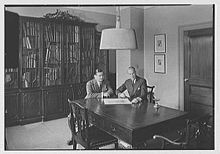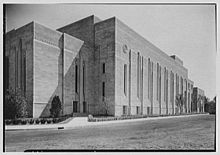- Eggers & Higgins
-
Eggers & Higgins was a New York architectural firm partnered by Otto Reinhold Eggers (1882–1964) and Daniel Paul Higgins (1886–1953). The architects were responsible for the construction phase of the Thomas Jefferson Memorial beginning in 1939, two years after the death of its original architect, John Russell Pope, despite protests that their appointment had been undemocratic and therefore "un-Jeffersonian." Critics argued a competition should have been held to choose Pope's successor. In 1941, they also completed construction of Pope's other famous design, the West Building of the National Gallery of Art, also in Washington D.C..
The pair were long time associates of Pope in the firm he founded in 1903 as the Office of John Russell Pope, Architect. Eggers was a brilliant designer and renderer who served as Pope's right hand for almost thirty years.[1] They changed the name of the firm to Eggers & Higgins in 1937, soon after Pope's death. The firm was renamed The Eggers Partnership in 1970, and then as The Eggers Group, PC when it became a professional corporation in 1976. It eventually merged into what is now RMJM Hillier, a leading architectural firm with offices in the United States, the United Kingdom, and Asia.
Eggers & Higgins also designed the Brooklyn War Memorial, a classical stone building in Cadman Plaza dedicated to Brooklynites who fought in World War II.[2] At the same time, they also designed the Vanderbilt Law School Building, now Vanderbilt Hall of the New York University School of Law.[2] For the 1939 New York World's Fair they designed the Railroads Building, the largest at the Fair, and the Schaefer center, a restaurant seating 1600 with a long open-air bar.[3] In Lincoln Center the firm developed Damrosch Park, an outdoor amphitheater with a bowl-style stage known as the Guggenheim Band Shell.[4]
In addition to their planning role with New York University on the redevelopment of Washington Square,[5] the firm was also engaged with Indiana University as their primary architects for more than 30 years. They designed all the major buildings on the Bloomington campus from the Indiana University Auditorium completed in 1941, until they were replaced on the musical arts center project in 1962.[6] Their major campus building designs included the Fine Arts Building, Lilly Library, the Stadium and Assembly Hall. They were also tapped for the development of the Indiana University School of Medicine campus including the Indiana University Hospital building.[7]
Other notable designs
- SS America (1940) (interior architects)
- Silliman College at Yale University (1940)
- Cardinal Hayes High School in The Bronx, New York (1941)
- Naval Training Center, Bainbridge, Maryland (1942)
- Le Moyne College in DeWitt, New York
- Morehead Planetarium at the University of North Carolina at Chapel Hill (1949)
- One, Two and Three Gateway Center in Pittsburgh, Pennsylvania (1952)
- Alfred E. Smith Houses, Manhattan, New York City (1952)
- SS United States (1952) (interior architects)
- The dormitories at Manhattanville College(1951-1963)
- U.S. Embassy, Ankara, Turkey (1953)
- Canada House in Midtown, Manhattan in New York City (1957) (with Marazio & Morris)
- Parran Hall at the University of Pittsburgh (1957)
- Dirksen Senate Office Building in Washington D.C. (1958)
- Cathedral of St. Joseph in Hartford, Connecticut (1962)
- Holy Trinity Chapel of the Generoso Pope Catholic Center of New York University Catholic Student Center (1964)
- St. Helena Church, Parkchester, Bronx, NY (1940)
- St.Claire Church, Staten Island, NY
- Church of Our Lady of Victory, Manhattan, New York City (1946)
- Jacob K. Javits Federal Building in the Civic Center, Manhattan district of New York City (1967) (with Alfred Easton Poor and Kahn & Jacobs)
- Manhattan Church of Christ (1967) on the Upper East Side in New York City
- One Pace Plaza at Pace University (1969)
- Eigenmann Hall at Indiana University (1969)
- Mutual Benefit Life Building in Philadelphia, Pennsylvania (1972)
- Bank of America Building in New York City (1986)
References
- ^ Sinclair, Evelyn; Peatross, C. Ford. Capital Drawings: Architectural Designs for Washington, D.C., from the Library of Congress. Baltimore: The Johns Hopkins University Press. ISBN 0-8018-7232-4.
- ^ a b Smith, Gibbs M.; Morrone, Francis; Iska, James (2001). An Architectural Guidebook to Brooklyn. Layton, Utah: Gibbs Smith Publishers. pp. 13–14. ISBN 1-58685-047-4.
- ^ Appelbaum, Stanley; Wurts, Richard (1977). The New York World's Fair, 1939/1940 in 155 photographs. New York: Dover Publications. ISBN 0-486-23494-0.
- ^ Iska, James; Morrone, Francis (2002). The Architectural Guidebook to New York City. Salt Lake City: Gibbs Smith. pp. 265. ISBN 1-58685-211-6.
- ^ Schwartz, Joel (1993). The New York approach: Robert Moses, urban liberals, and redevelopment of the inner city. Columbus: Ohio State University Press. pp. 138. ISBN 0-8142-0587-9.
- ^ Logan, George M. (2000). The Indiana University School of Music: a history. Bloomington: Indiana University Press. pp. 223. ISBN 0-253-33820-4.
- ^ Herman B. Wells (1980). Being Lucky: Reminiscences and Reflections (Indiana). Bloomington: Indiana University Press. pp. 198. ISBN 0-253-11556-6.
External links
- Emporis: Eggers & Higgins
- Thomas Jefferson Memorial by the National Park Service
- Designing the future of higher education - Profile of the Week - The Eggers Group, P.C - Company Profile at Find Articles
- Morehead Planetarium and Science Center :: Morehead History: Part 2
- Time Magazine, Friday, May. 01, 1964
Categories:- American architects
- Architecture firms based in New York City
- Defunct architecture firms based in New York City
- Architects of Roman Catholic churches
- Eggers & Higgins buildings
Wikimedia Foundation. 2010.


